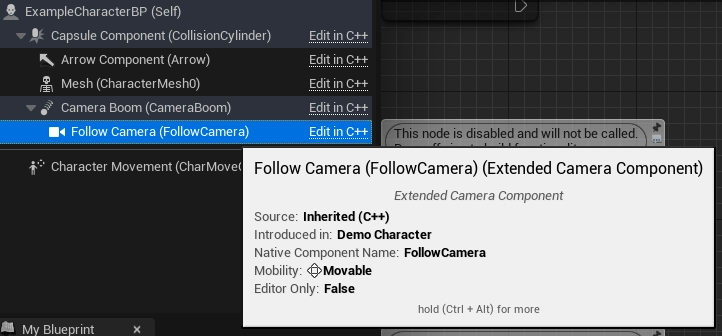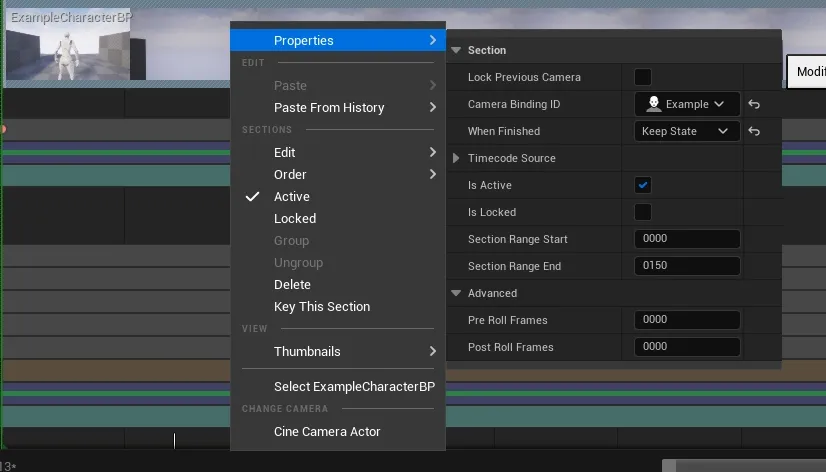Documentation – Extended Camera
Usage
The ExtendedCameraComponent is intended to be a drop-in replacement for the original CameraComponent found on the default Unreal Engine player classes.

The extra features of the ExtendedCameraComponent can be used in Blueprint, C++, or Sequencer.
Sequencer
All keys in the component are drivable in a sequence.
For convenience, a tracked camera may be specified to match its transform. Some parameters, such as Field of View, will also be copied, but custom post-processing information will not be copied.

In this configuration, only three keys are required: Tracked Camera, Camera Secondary Track Blend Alpha, and Write Tracked to Secondary. The secondary track is used over the primary track as the primary blends first. So 50% Primary + 50% Secondary gives you 25% original, 25% primary, and 50% secondary.
It is also possible to forego Write Tracked to Secondary and replace Camera Secondary Track Blend Alpha with Camera Primary Track Blend Alpha. This is functionally identical.
C++ & Blueprint
Every major function of the ExtendedCameraComponent in C++ is available as a blueprint node too.
Functions
For functions that have primary and secondary versions, the shorthand <Track> will substitute.
Get<Track>CameraTrackAlpha
| Parameters | Type | Returns | Type |
|---|---|---|---|
| - | - | Track Alpha | float |
GetUse<Track>Track
| Parameters | Type | Returns | Type |
|---|---|---|---|
| - | - | Is <Track> in use? | bool |
GetCameraMode
| Parameters | Type | Returns | Type |
|---|---|---|---|
| - | - | Current Camera Mode | EExtendedCameraMode |
Set<Track>CameraTrackAlpha
| Parameters | Type | Returns | Type |
|---|---|---|---|
| Value to Set | float | - | - |
Sets the blend amount for <Track>
SetCamera<Track>Track
| Parameters | Type | Returns | Type |
|---|---|---|---|
| Track Location | FVector | - | - |
| Track Rotation | FRotator | - | - |
| Track FOV | float | - | - |
Sets the location, rotation, and FOV for <Track>.
SetCamera<Track>Transform
| Parameters | Type | Returns | Type |
|---|---|---|---|
| Track Transform | FTransform | - | - |
| Track FOV | float | - | - |
Sets the location, rotation, and FOV for <Track>
SetCamera<Track>LocationRotation
| Parameters | Type | Returns | Type |
|---|---|---|---|
| Track Location | FVector | - | - |
| Track Rotation | FRotator | - | - |
Sets both the location and rotation for <Track>
SetCamera<Track>Rotation
| Parameters | Type | Returns | Type |
|---|---|---|---|
| Track Rotation | FRotator | - | - |
Sets new rotation for <Track>
SetCamera<Track>Location
| Parameters | Type | Returns | Type |
|---|---|---|---|
| Track Location | FVector | - | - |
Sets new location for <Track>
SetCamera<Track>FOV
| Parameters | Type | Returns | Type |
|---|---|---|---|
| Track FOV | float | - | - |
Sets new FOV for <Track>
SetCameraMode
| Parameters | Type | Returns | Type |
|---|---|---|---|
| New Mode | EExtendedCameraMode | - | - |
Sets Line-of-sight maintenance mode.
Common Issues
Camera resets to an odd location after the sequence ends
This is cased by the camera cut feature of Sequencer. If the player camera was the cut camera, then when the sequence ends, it reverts to a camera at the player characters origin – local (0,0,0).
The good news is that there are at least three ways to fix this.
- Disable Camera Cuts on the sequence
- Have Sequencer keep the camera cut state after the sequence
- Don't supply a camera cut track in the shot
Disabling Camera Cuts

The downside here is that it disables cuts for the entire sequence, meaning that if you wanted to have an establishing shot then a cut to the character that blends out, you'll have a camera that's stuck.
Keep State

This setting is found in the camera cut track of each shot. It's only needed in the final shot, so it won't break previous cuts.
No Camera Cut Track
LedgeSequence in the demo project uses this method. It's a very simple sequence, so there's not much need to have a cut track.